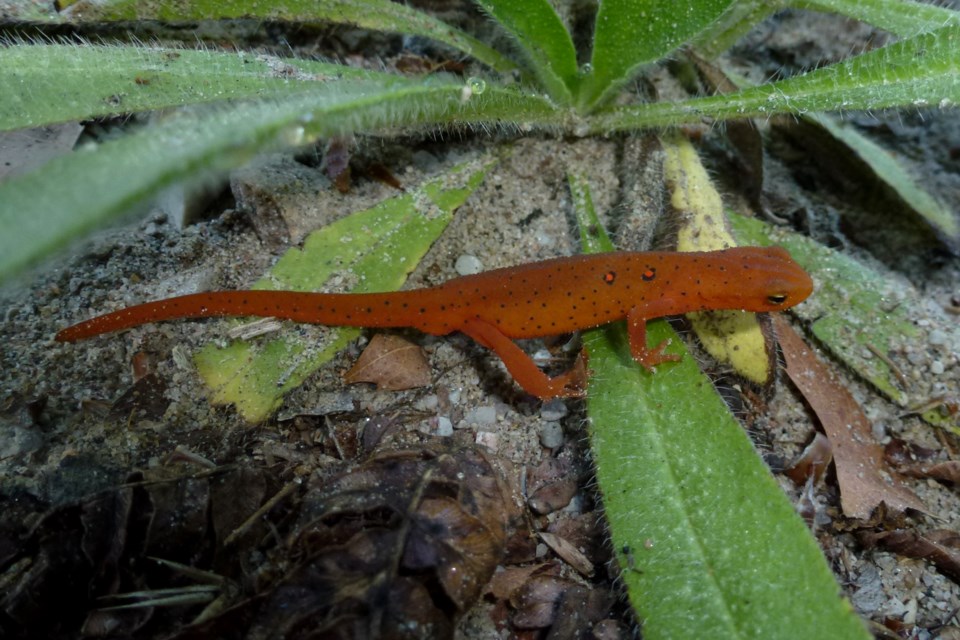The trouble with spring is that everything happens at once: weather changes, flowers bloom, birds return, frogs call, and fish spawn. As this huge wave of activity sweeps across our region it is both exciting and (from a naturalist's point of view) frustrating, as one tries to see it all.
As you walk along looking up for migrating songbirds flitting among the branches you risk stepping on wildflowers, and as you scan the woodlot floor for delicate blooms you may miss an elusive bird species flying by overhead. It's all just too much, I tell ya!
The other day, while working in a recently thawed hardwood forest, I had an experience with a ‘fire lizard’ (a.k.a. salamander), several in fact. Fire lizards are oft overlooked due to the distracting loud calls and splashy colours of other forest creatures; indeed, on this day a pileated woodpecker was drumming nearby on a dead branch, staking out its territorial boundary, while a few spring peepers called from a wet puddle.
A brown creeper scaled the bark of a dead butternut tree while two robins bobbed along through the wet layers of dead maple leaves. It was when I flipped an old chunk of fallen tree limb out of my way that I saw an almost forgotten friend, a red-backed salamander.
Salamanders are so easily overlooked, even when they are at their peak activity, which is in the early spring. Of the 11 species of salamanders which may be found in Ontario at least six can be found in our area: red-backed, yellow-spotted, blue-spotted, four-toed, mud puppy, and the red-spotted newt.
As the icy cold ponds of meltwater form after a bit of a snow melt, and just as the frost leaves the ground, these creatures return to the ponds of their origin and begin their mating rituals.
A good flashlight and a midnight stroll may reveal to you a few yellow-spotted or blue-spotted salamanders going about their intimate business.
To call them ‘fire lizards’, as they were so labelled dating back to about 30 A.D. by Pliney, is to perpetuate a myth. First of all, lizards have claws and scaly skin, neither of which occur on any salamander, so that shoots down that bit of nomenclature. I suppose that since the Peterson Field Guide to Reptiles and Amphibians had not yet been published in the time of Pliney, the ancients can be forgiven for mixing up lizards (a reptile) and salamanders (an amphibian).
The 'fire' part is even more interesting. During the winter months many salamanders burrow into the soil to get below the frost line, some going a metre or more deep.
When the sun shines warmly again after a bitterly cold winter, and suddenly salamanders are noted in the ponds, the early Native folks needed an explanation for this event, so they added one plus one and came up with a good story: it was the salamanders who took the sun deep underground last fall and since today is sunny and warm and there is a salamander right in front of me, it became quite obvious that the salamanders had brought back the sun.
In Europe the fire lizard myth started, apparently, when a learned individual put a log on the fire, out squirmed a salamander and the fire went out. This event, coupled with several glasses of grog, started the widespread understanding that salamanders are keepers of fire, and can even put out a fire with their wet looking skin.
OK, so, if salamanders like to live in wet, rotting, fallen logs and such, and I was to put a wet, rotting piece of wood in my fireplace, shouldn't I expect the fire to, like, go out? Perhaps the wine tainted the story a tad.
However, as we people like (prefer?) to go with a good story when reliable scientific evidence is lacking (or present), the fire lizard legend stuck around for several centuries, even spawning some spiritual cults that have the salamander as the keeper of the element of fire.
The wet skin of a salamander is critical to its survival, as some species of the little creatures do not have lungs to take in oxygen. As air touches the skin, a chemical process takes place and oxygen particles are absorbed into the animal, thus eliminating the need to breathe in air.
However, as this thin layer of moisture is absorbent, it can also take in excess salt washed in from nearby roads, any chemical that is carried by water, or the insect repellent that you sprayed on your hand just before you picked up said fire lizard.
If you are a 24/7 kind of naturalist, there is something going on out there every day and night during springtime. After a full night of frog calling and salamander tracking, you can be witness to dawn's early chorus of bird song, followed by a day of observing migrating birds and wrapped up with an evening bonfire and a bout of stargazing.
Who needs sleep when you can watch nature, drink wine and come to some amazing conclusions!
